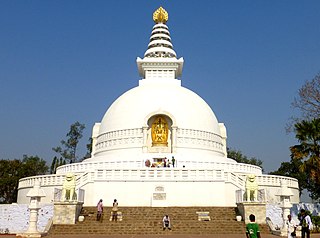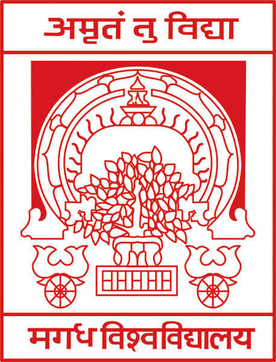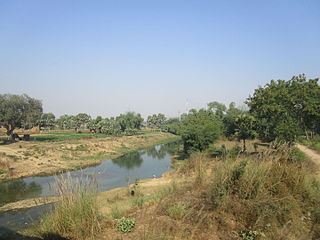
Magadha also called the Kingdom of Magadha or the Magadha Empire, was a kingdom and empire, and one of the sixteen Mahajanapadas, 'Great Kingdoms' of the Second Urbanization, based in southern Bihar in the eastern Ganges Plain, in Ancient India. Magadha was ruled by the Brihadratha dynasty, the Haryanka dynasty, the Shaishunaga dynasty, the Nanda dynasty, the Mauryan dynasty, the Shunga dynasty and the Kanva dynasty. It lost much of it territories after being defeated by the Satavahanas of Deccan in 28 BC and was reduced to a small principality around Pataliputra. Under the Mauryas, Magadha became a pan-Indian empire, covering large swaths of the Indian subcontinent and Afghanistan.

Magahi, also known as Magadhi, is a Indo-Aryan language spoken in Bihar, Jharkhand and West Bengal states of eastern India, and in the Terai of Nepal. Magadhi Prakrit was the ancestor of Magahi, from which the latter's name derives.

Rajgir, meaning "The City of Kings," is a historic town in the district of Nalanda in Bihar, India. As the ancient seat and capital of the Haryanka dynasty, the Pradyota dynasty, the Brihadratha dynasty and the Mauryan Empire, as well as the dwelling ground of such historical figures as The Buddha and The Mahavira, the city holds a place of prominence in Hindu, Buddhist and Jain scriptures. As of 2011, the population of the town was reported to be 41,000 while the population in the community development block was about 88,500.

Gaya is a city, municipal corporation and the administrative headquarters of Gaya district and Magadh division of the Indian state of Bihar. Gaya is 116 kilometres (72 mi) south of Patna and is the state's second-largest city, with a population of 470,839. The city is surrounded on three sides by small, rocky hills, with the Phalgu River on its eastern side.

Bihar Sharif is the headquarters of Nalanda district and the fifth-largest sub-metropolitan area in the eastern Indian state of Bihar. Its name is a combination of two words: Bihar, derived from vihara, also the name of the state; and Sharif. The city is a hub of education and trade in southern Bihar, and the economy centers around agriculture supplemented by tourism, the education sector and household manufacturing. The ruins of the ancient Nalanda Mahavihara, a UNESCO World Heritage Site, are located near the city.

Magadh University is a public state university and institution of higher education in Bodhgaya, Bihar, India. It is recognised by the University Grants Commission (UGC).

Patna district is one of the thirty-eight districts of Bihar state in eastern India. Patna, the capital of Bihar, is the district headquarters. The Patna district is a part of Patna division. The Patna district is divided into 6 Sub-divisions (Tehsils) i.e. Patna Sadar, Patna City, Barh, Masaurhi, Danapur and Paliganj.

Sheikhpura district is one of the thirty-eight districts of the Indian state of Bihar. Sheikhpura is the administrative headquarter of this district. Sheikhpura district is a part of the Munger division. Sheikhpura was split from the Munger district into a separate district with headquarters in Sheikhpura on 31 July 1994 due to political efforts of Rajo Singh. As of 2011 it was the least populous district of Bihar.

Nawada district is one of the thirty-eight districts of the Indian state of Bihar. Nawada is its administrative headquarters. The district is the easternmost district of the Magadh division, one of the nine administrative divisions of Bihar. The area of the modern district was historically part of the Magadha, Shunga and Gupta empires. Koderma and Giridih districts of the state of Jharkhand lie on the southern border of the district; it also shares borders with the Gaya, Nalanda, Sheikhpura, and Jamui districts of Bihar.

Arwal district is one of the thirty-eight districts of Bihar state, India, and Arwal town is the administrative headquarters of this district. It was earlier part of Jehanabad district.

Aurangabad district is one of the thirty-eight districts of Bihar state, India. It is currently a part of the Red Corridor.

Jehanabad district is one of the thirty-eight districts of Bihar state, India. Jehanabad town is the administrative headquarters of this district. Jehanabad district is a part of Magadh Division, and is located on the confluence of two small rivers called Dardha and Yamunaiya.

Koderma district is one of the twenty-four districts of Jharkhand state, India, and Koderma is the administrative headquarters of this district.
Aurangabad is a city in Aurangabad District, Bihar, India. It is the district's centre of governance and has a population of 102,244 as of 2011. The people of this region speak Magahi and Hindi.

Magadh division is an administrative geographical unit of Bihar state of India. Gaya is the administrative headquarters of the division. Currently (2005), the division consists Gaya district, Nawada district, Aurangabad district, Jehanabad district, and Arwal district. The current divisional commissioner is Mayank Warwade, an IAS officer of 2001 batch of Bihar cadre. Magadh is home to the Magahi culture. People speak Magahi language here.
Makhdumpur is a town in the Bihar state of India. It is a major town of Jehanabad district and Patna-Gaya Corridor. The Barabar Hills/Barabar Caves tourist region is 10 KM South-East of Makhdumpur proper city.
Konch is a community development block of Gaya district in Bihar, India. Konch(Konch Village/Konch Panchayat/Konch Thana-Police Station) is a typical village market area slowly taking shape of a sub-urban settlement and centre of small business. Konch has very important temple known as Koncheswar Mahadev belonging to the later Gupta period which now has been taken under the protection of Archaeological Survey of India (ASI).
Hinduism is the most followed religion in Bihar, followed by nearly 82.7% of total population as per 2011 Census. Islam is the second-most followed religion which is followed by nearly 16.8% of population. There is also a significant population of Jains and Christians in the state.

Rajauli is a tehsil, block and subdivision (sub–district) in Nawada district of Magadh division of the Indian state of Bihar. The tehsil of Rajauli is located at a distance of about 30 kilometres (19 mi) from Nawada city on National Highway 20 and is situated on the bank of Dhanarjay river. Rajauli, a Scheduled Caste (SC) reserved Assembly Constituency (AC) seat, had a total of 302900 electors during the 2015 Bihar Legislative Assembly election. Rajauli subdivision consists of 95 panchayats and 688 revenue villages while Rajauli block consists of 17 panchayats and 169 revenue villages.
Most of the languages of Bihar, the third most populous state of India, belong to the Bihari subgroup of the Indo-Aryan family. Chief among them are Bhojpuri, spoken in the west of the state, Maithili in the north, Magahi in center around capital Patna. Maithili has official recognition under the Eighth Schedule to the Constitution of India. The official language of Bihar is Modern Standard Hindi, with Standard Urdu serving as a second official language in 15 districts.
















